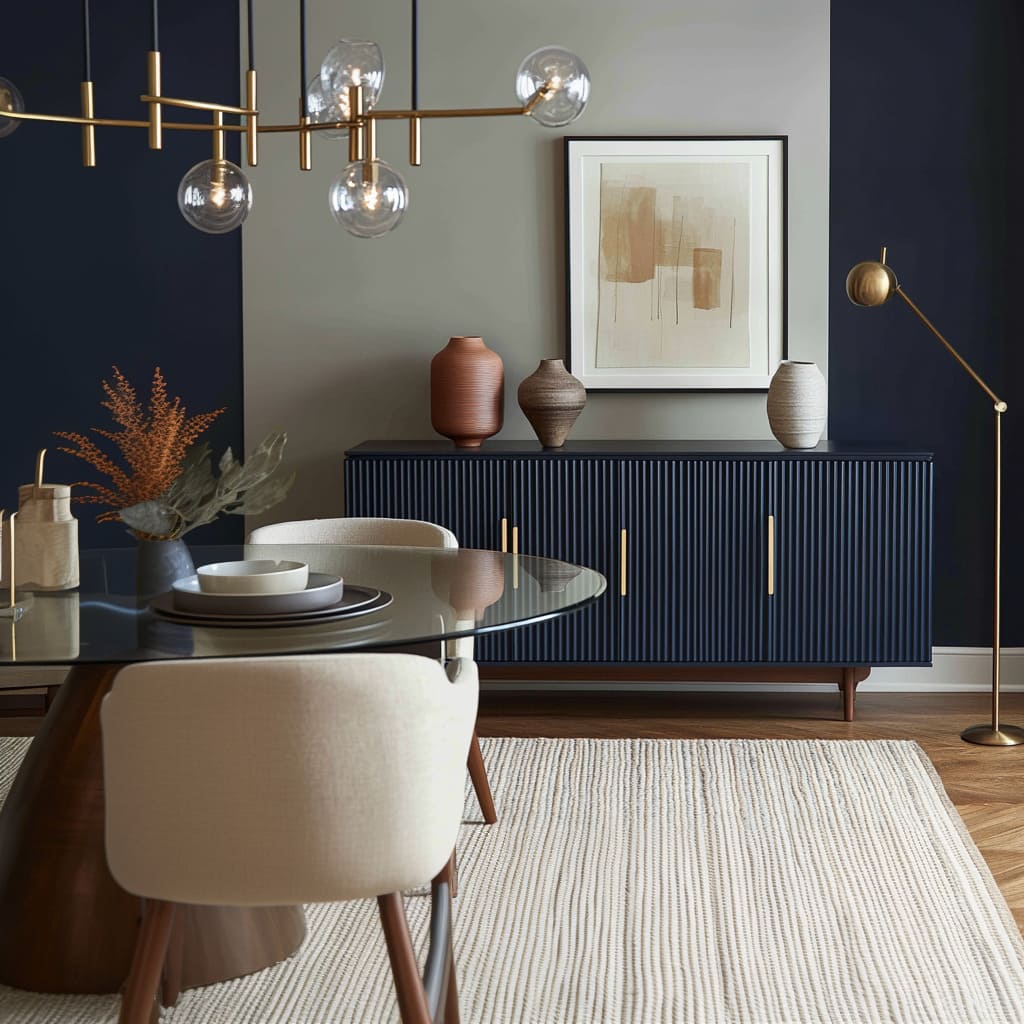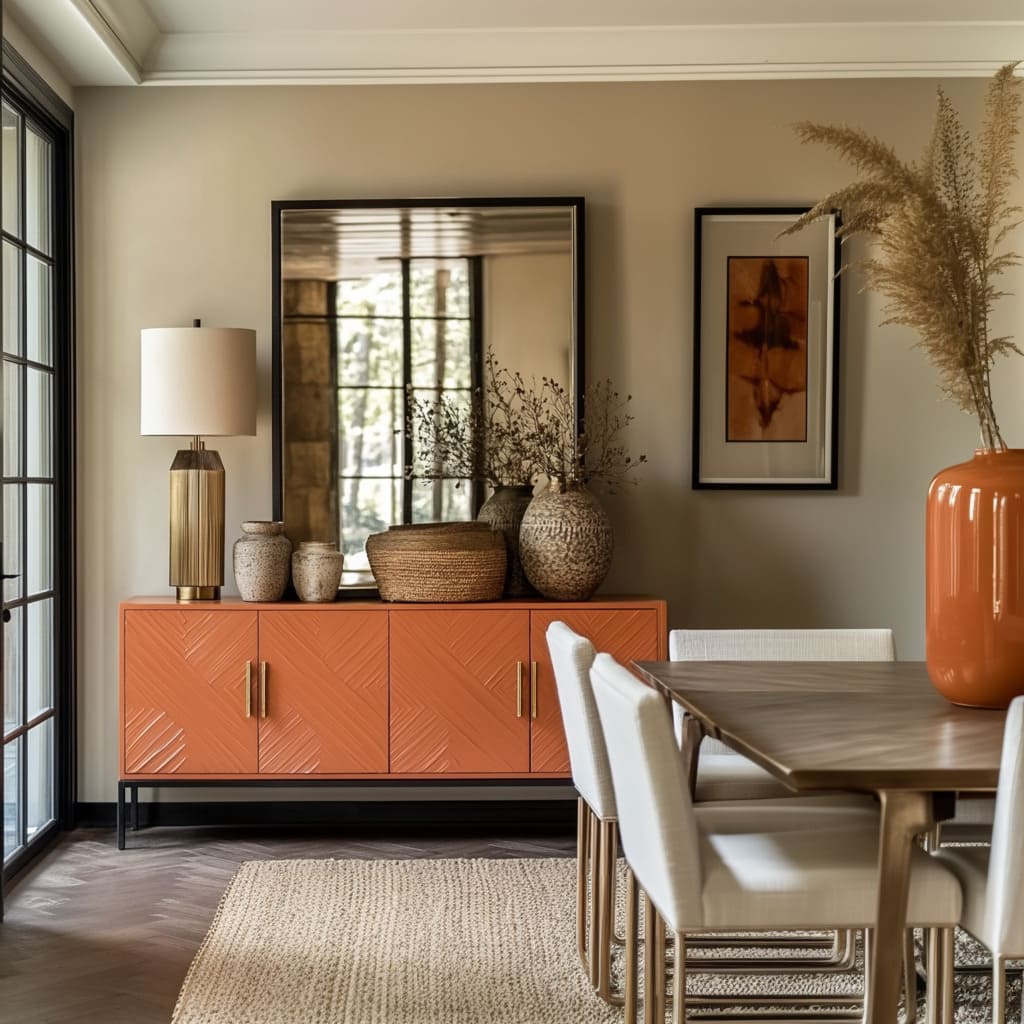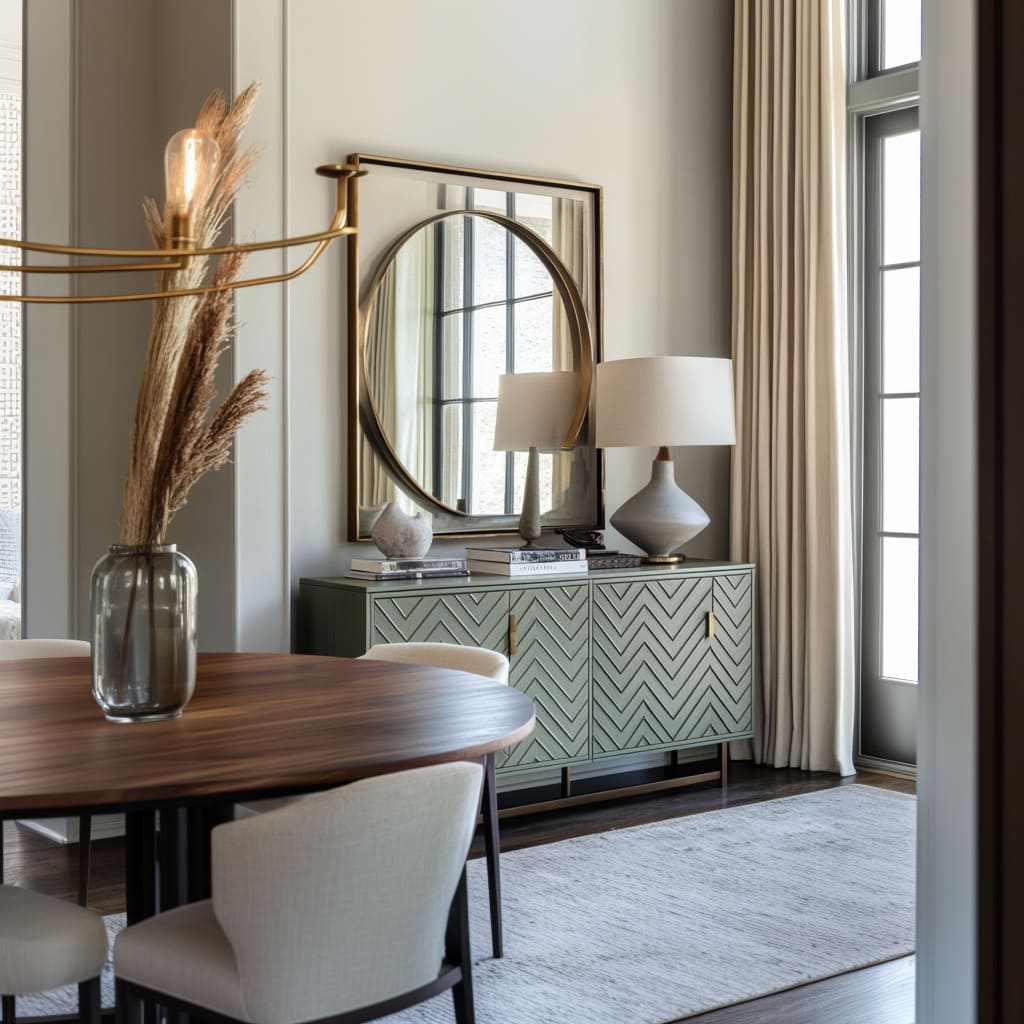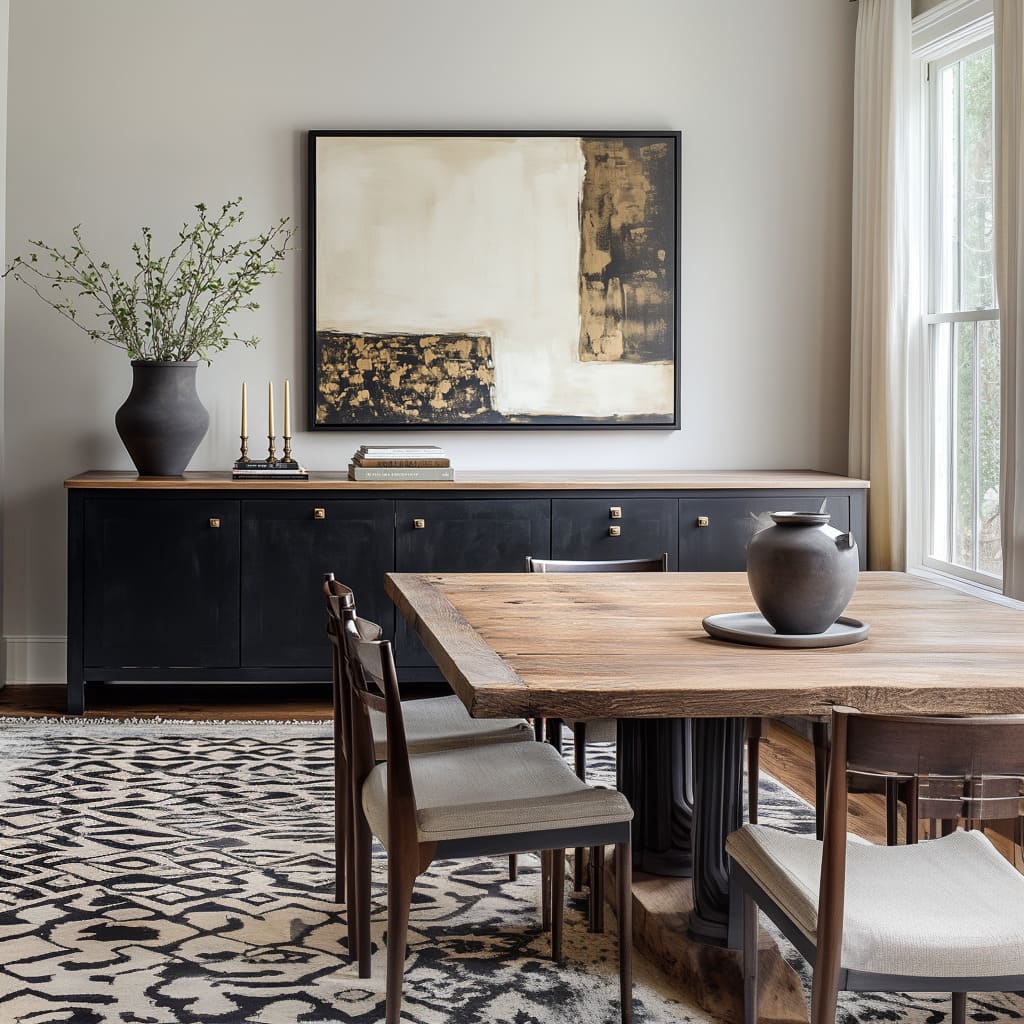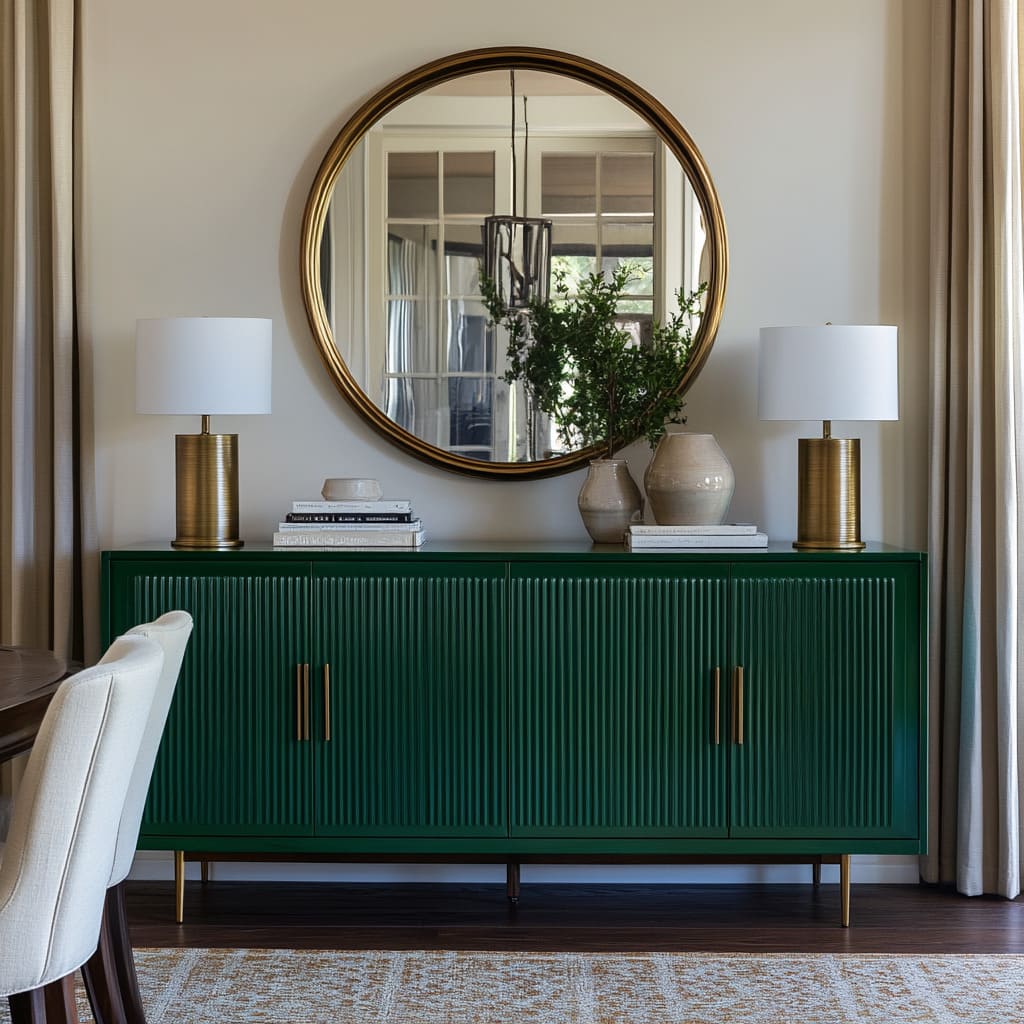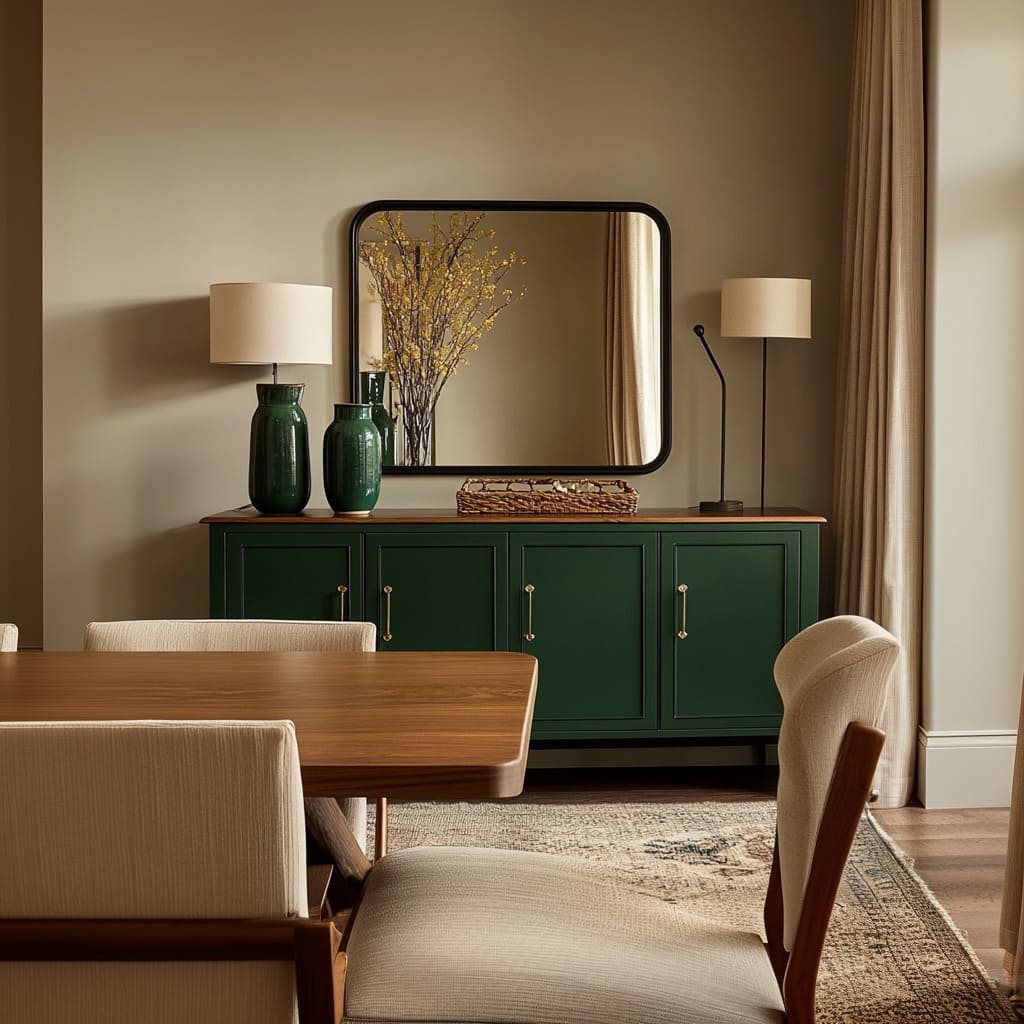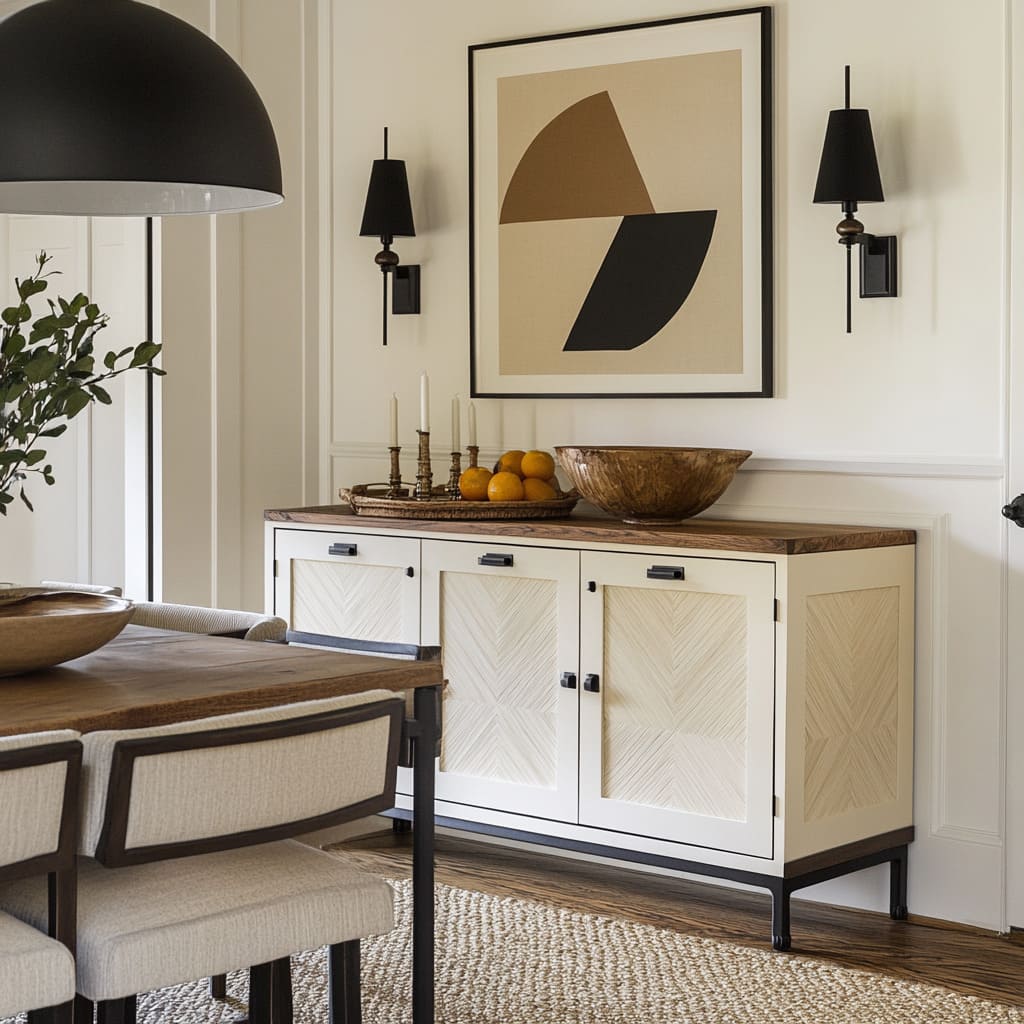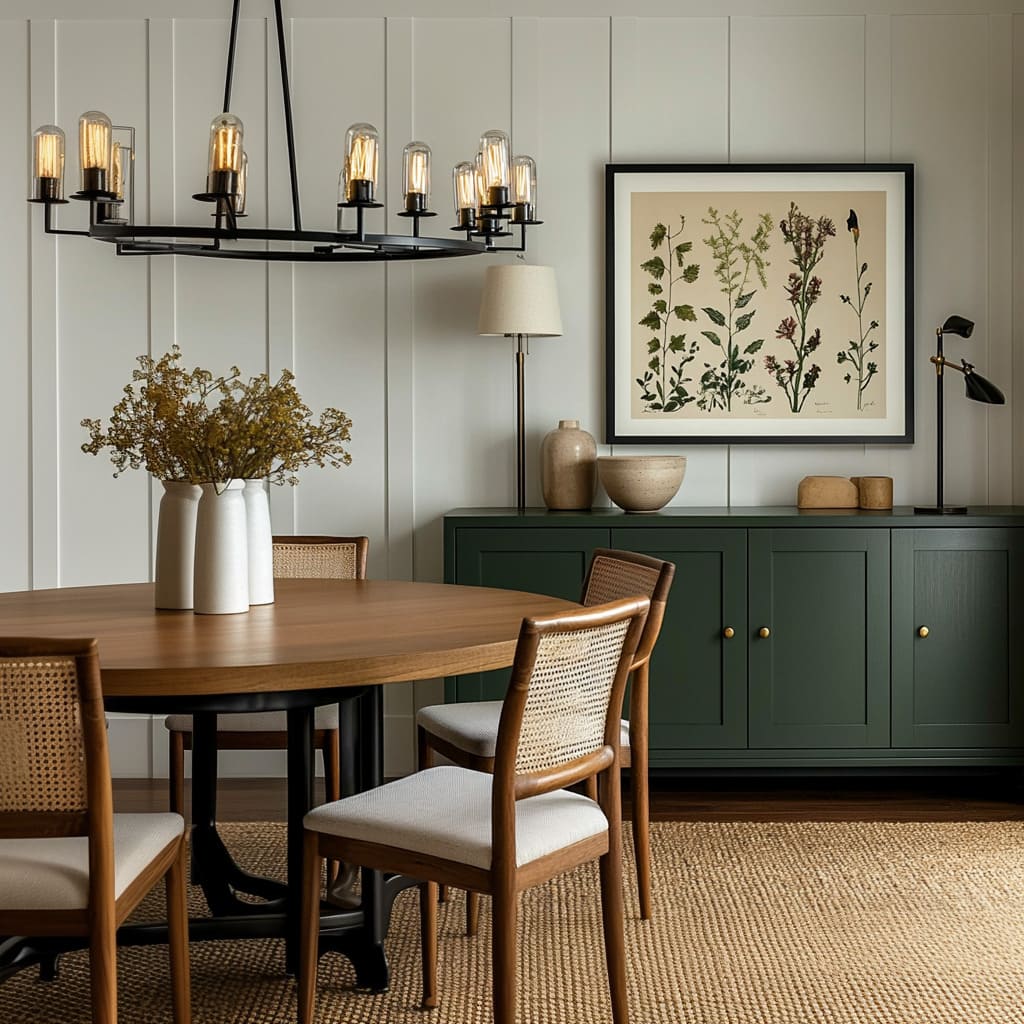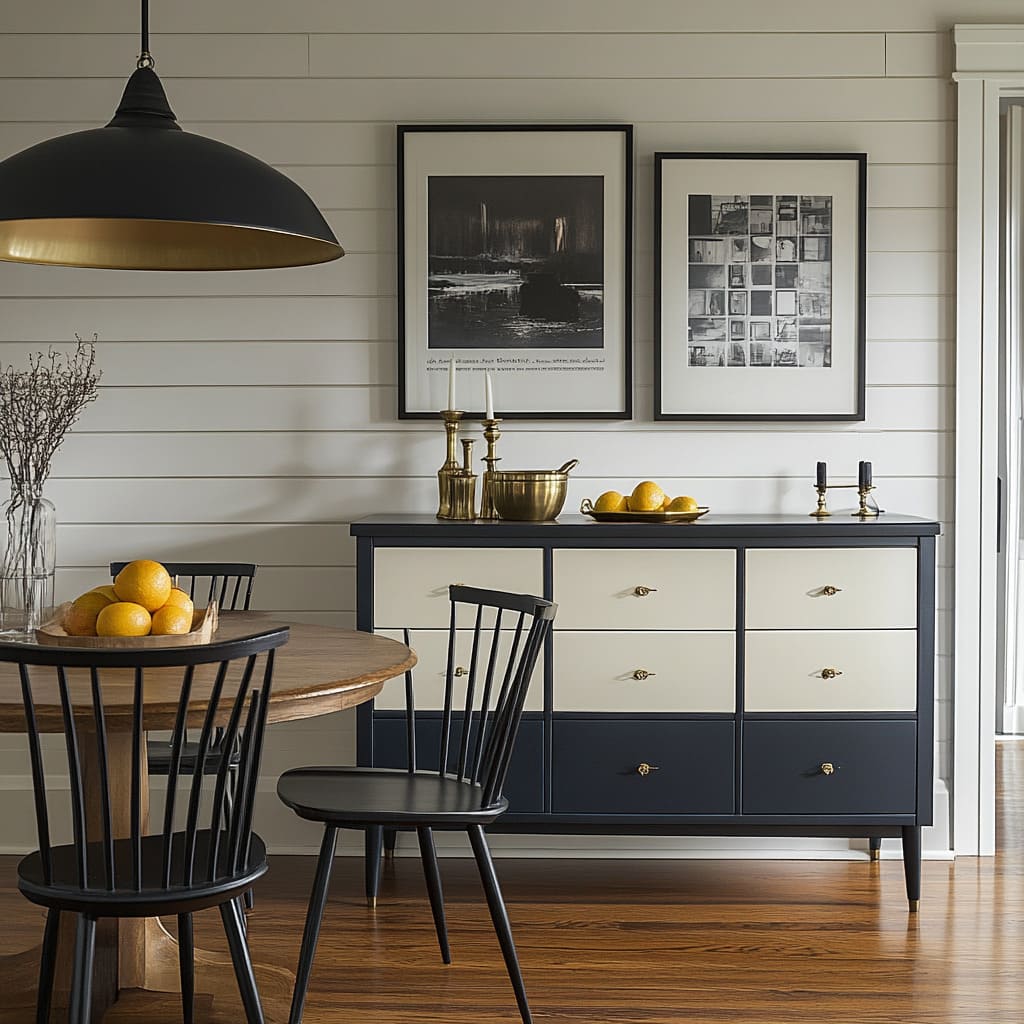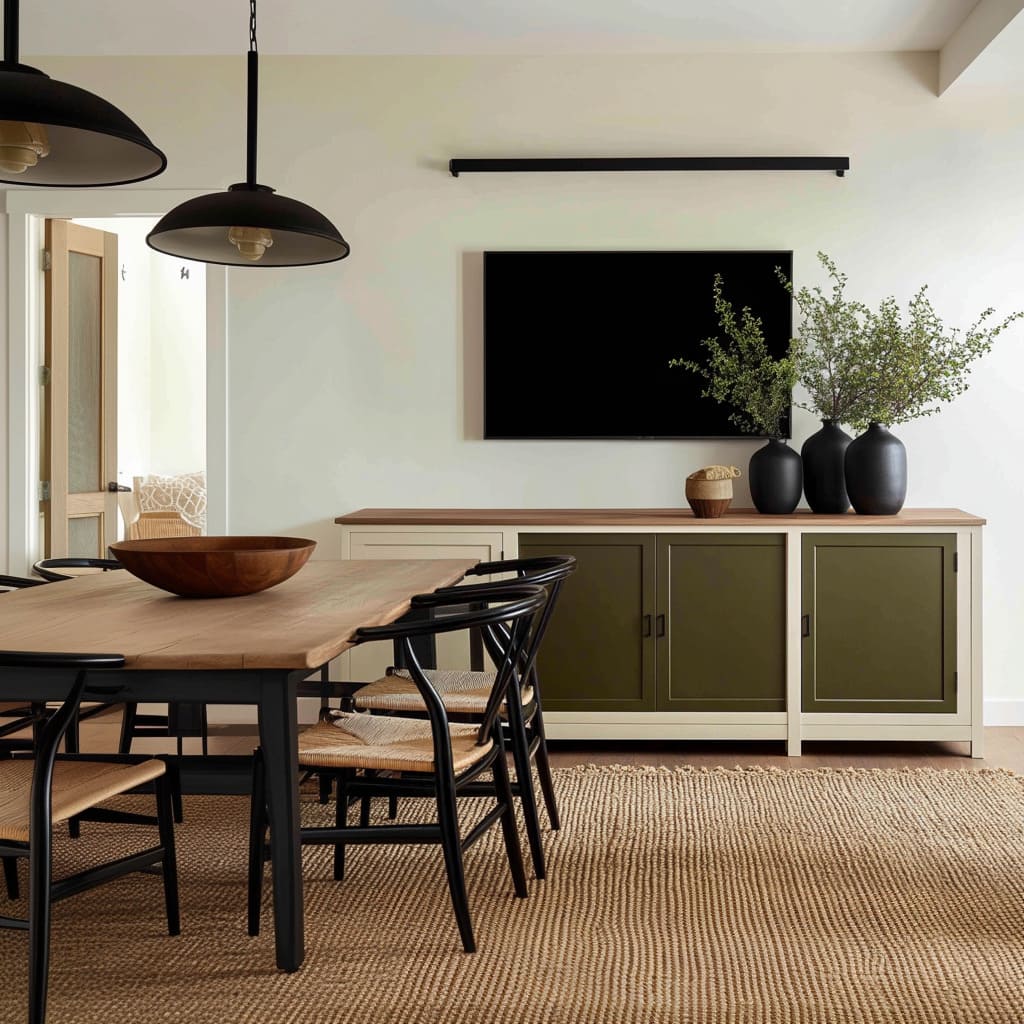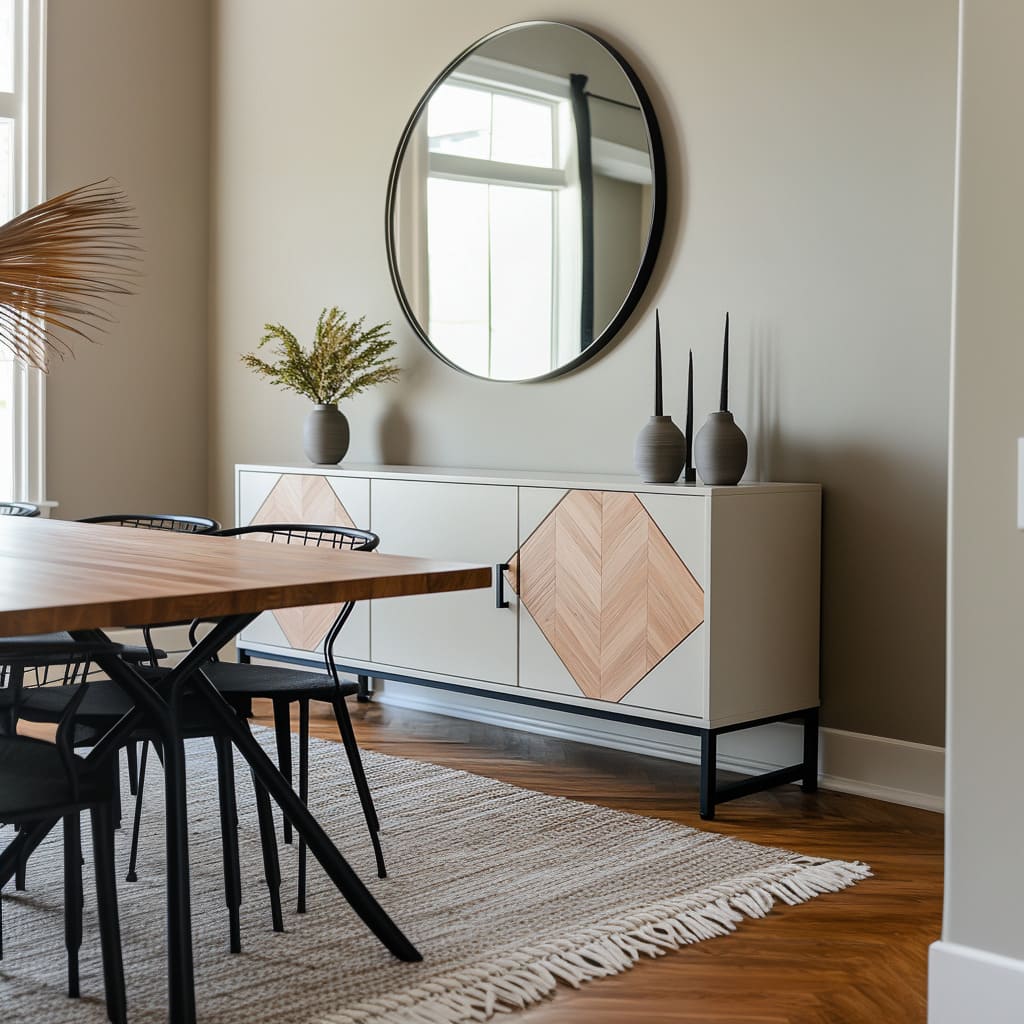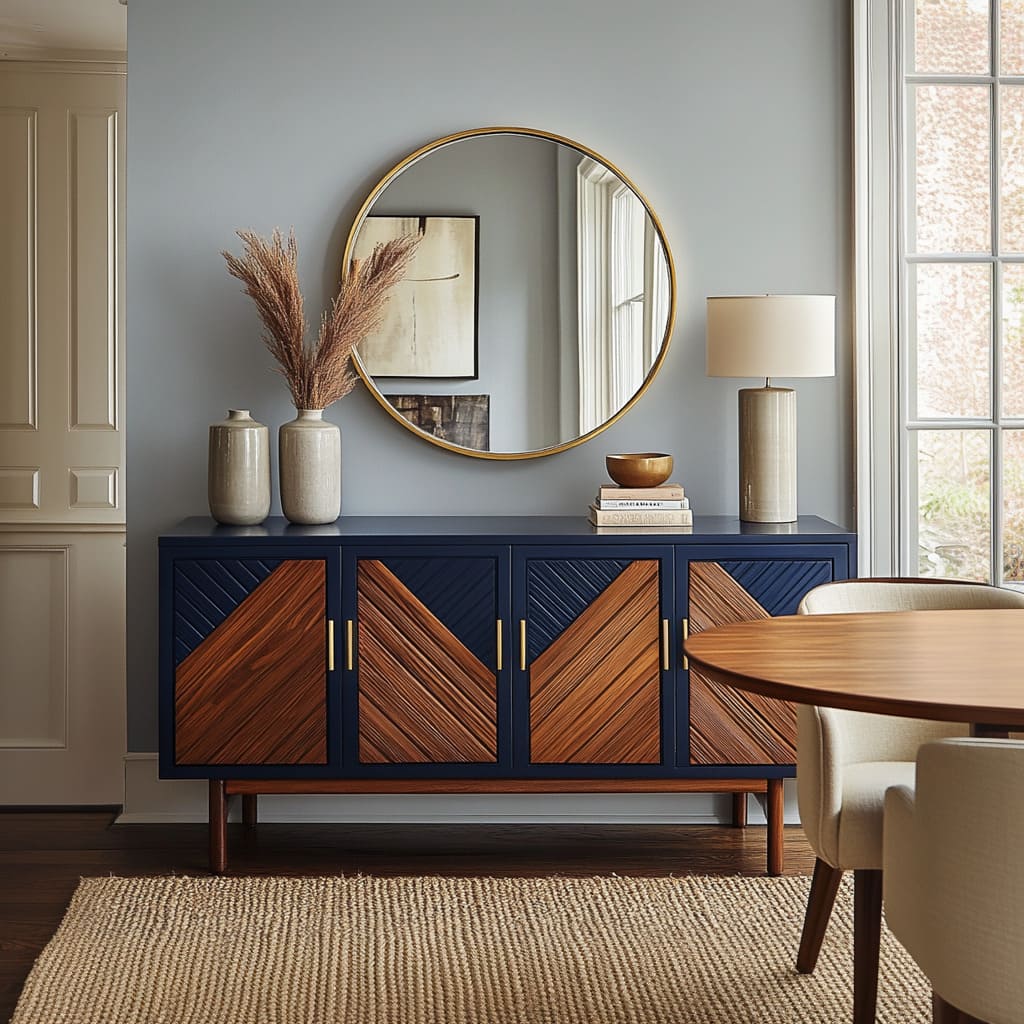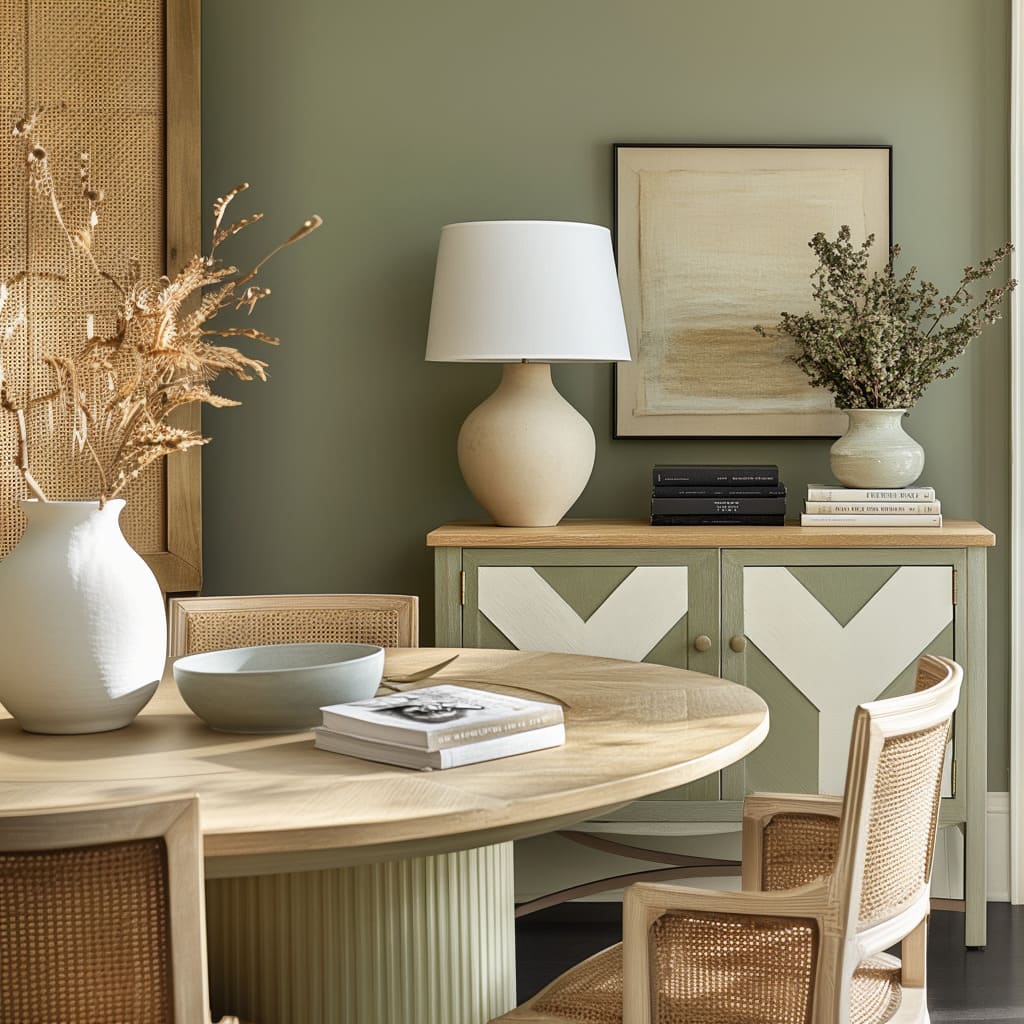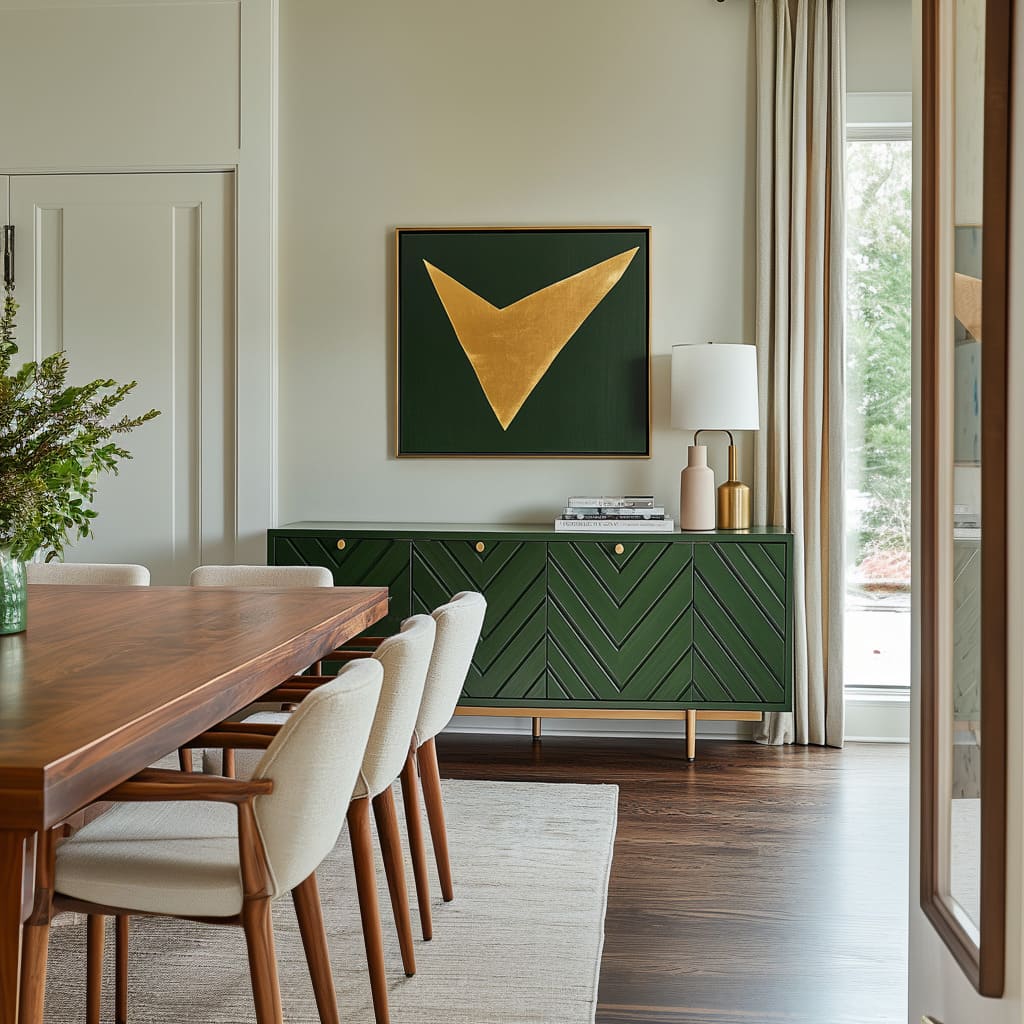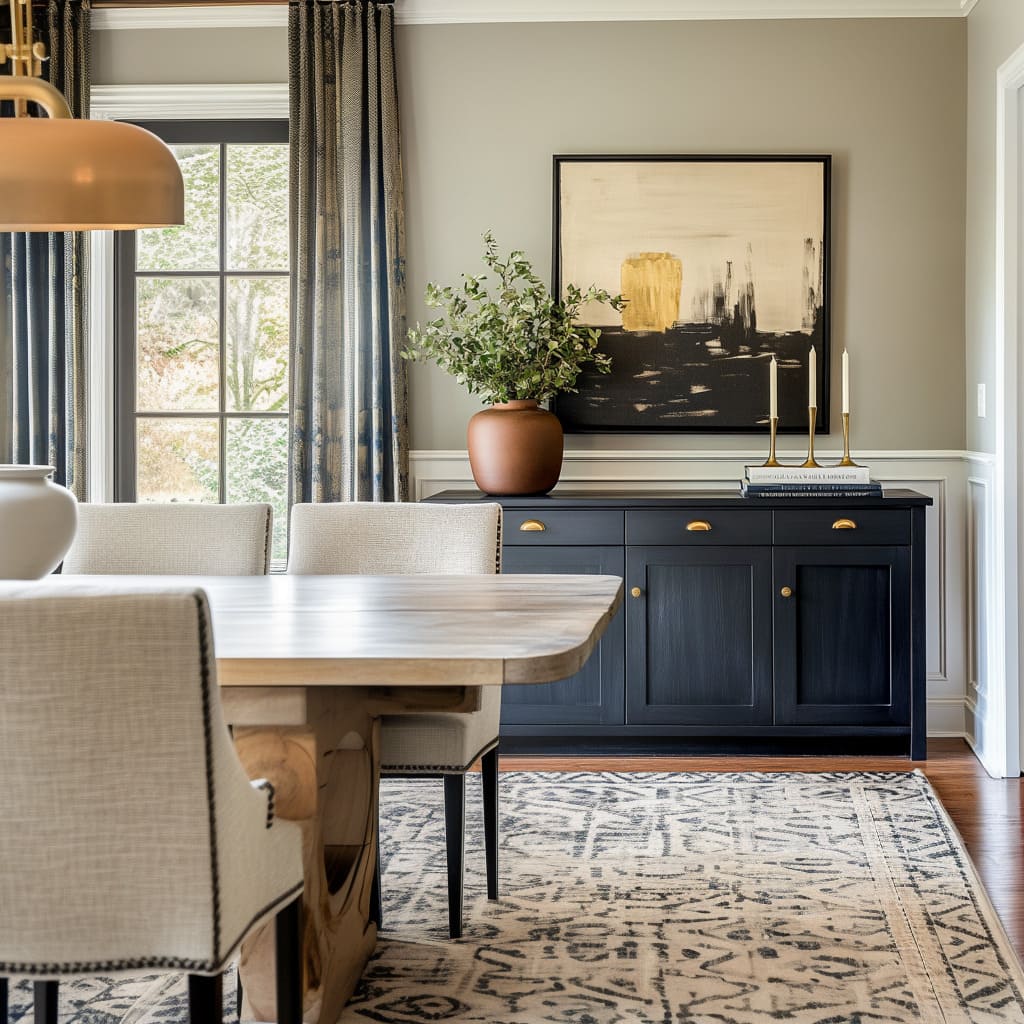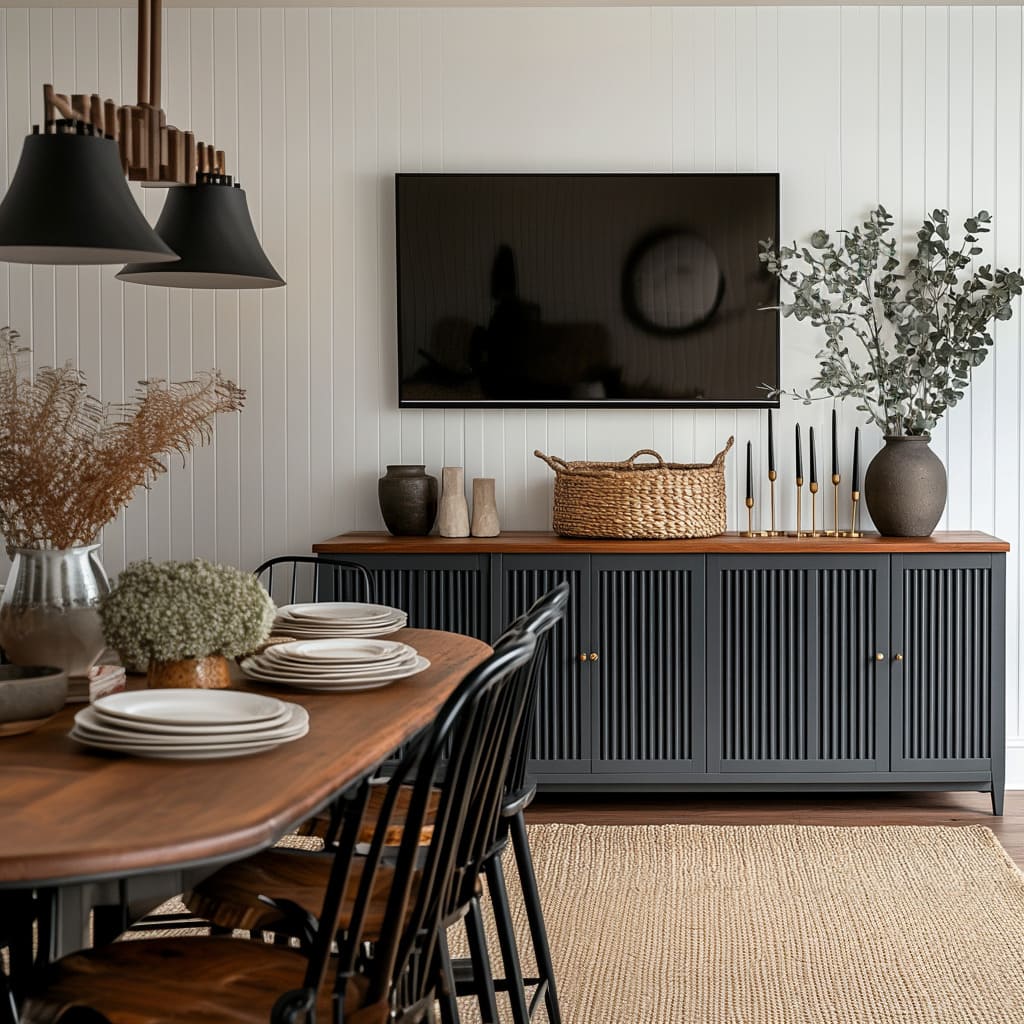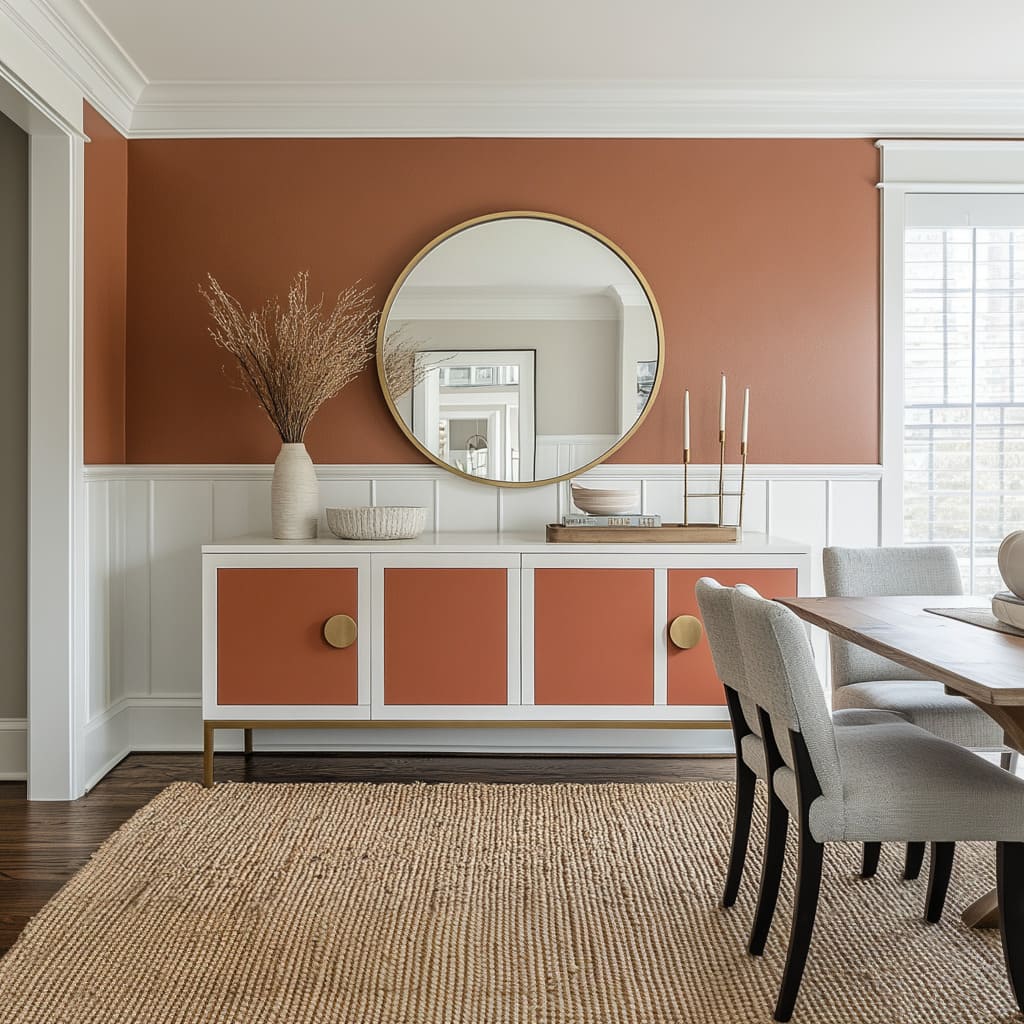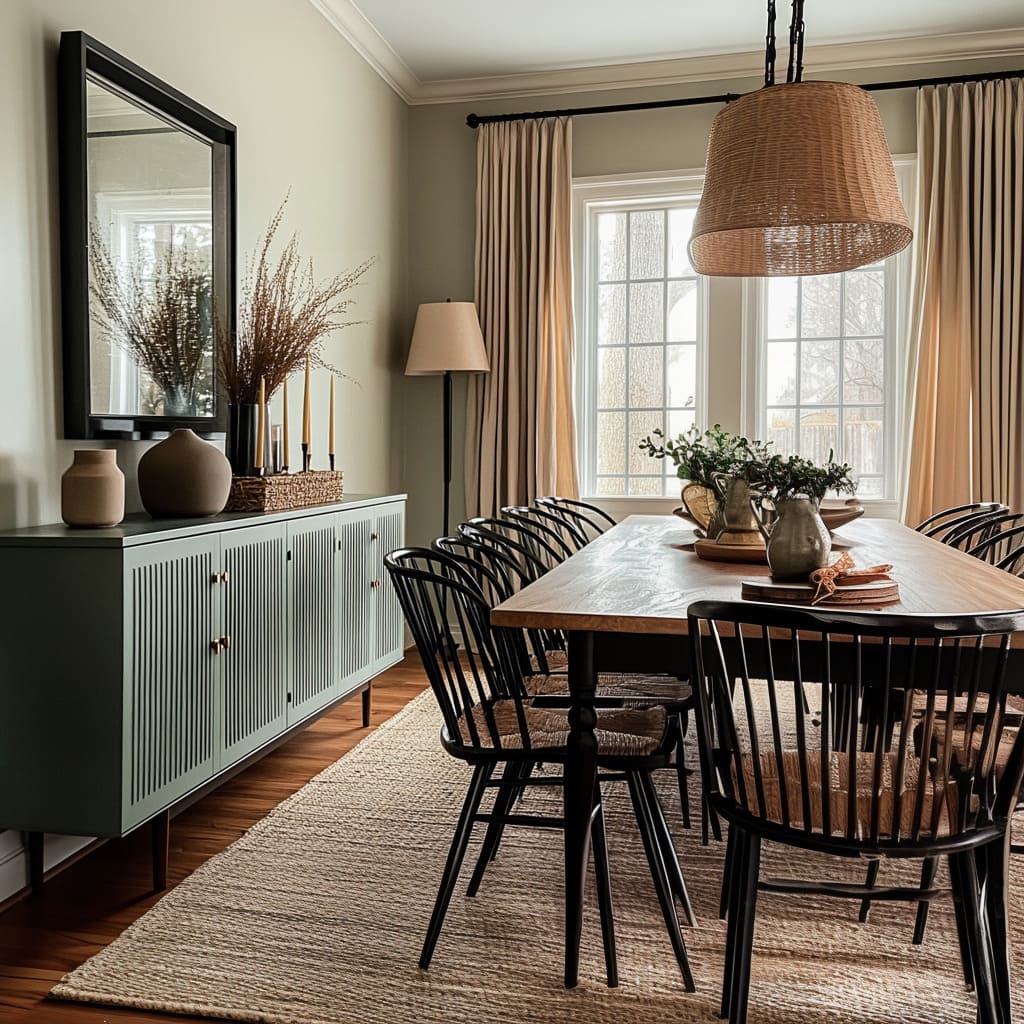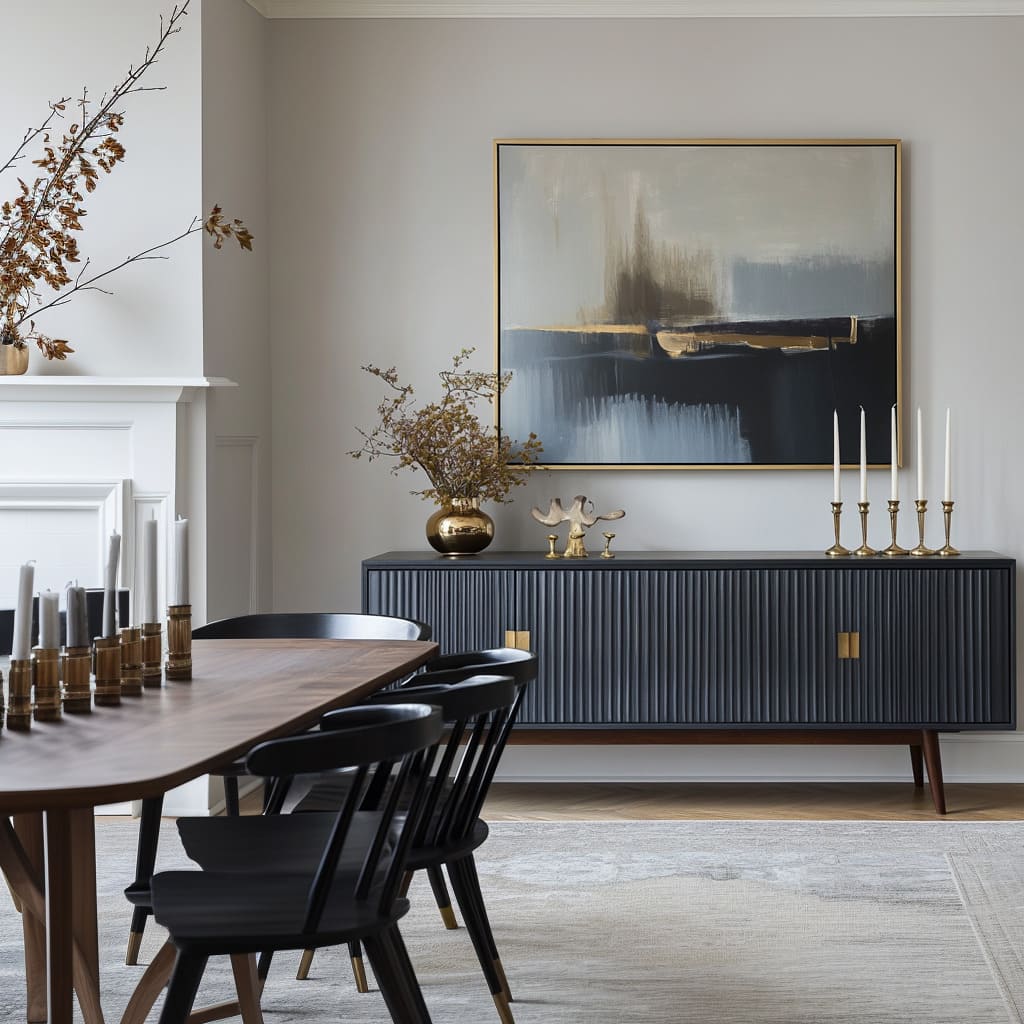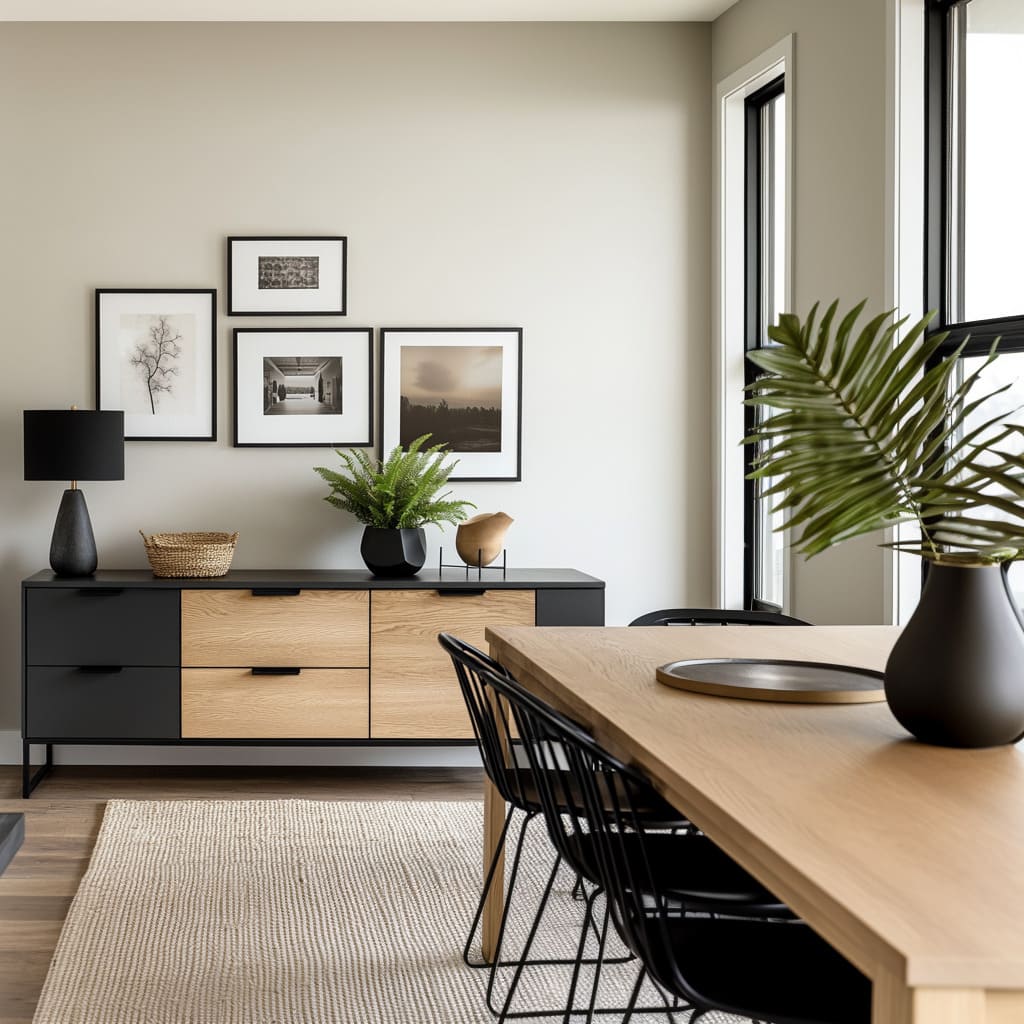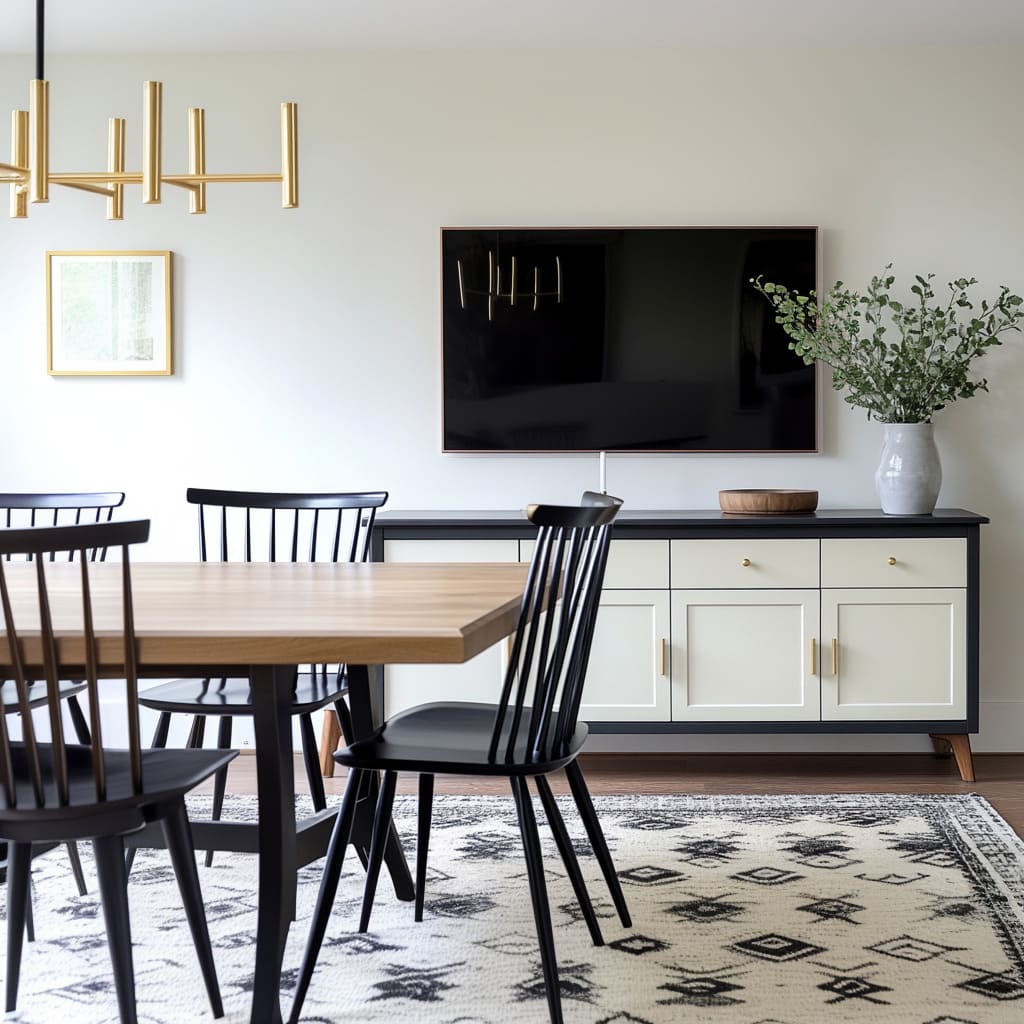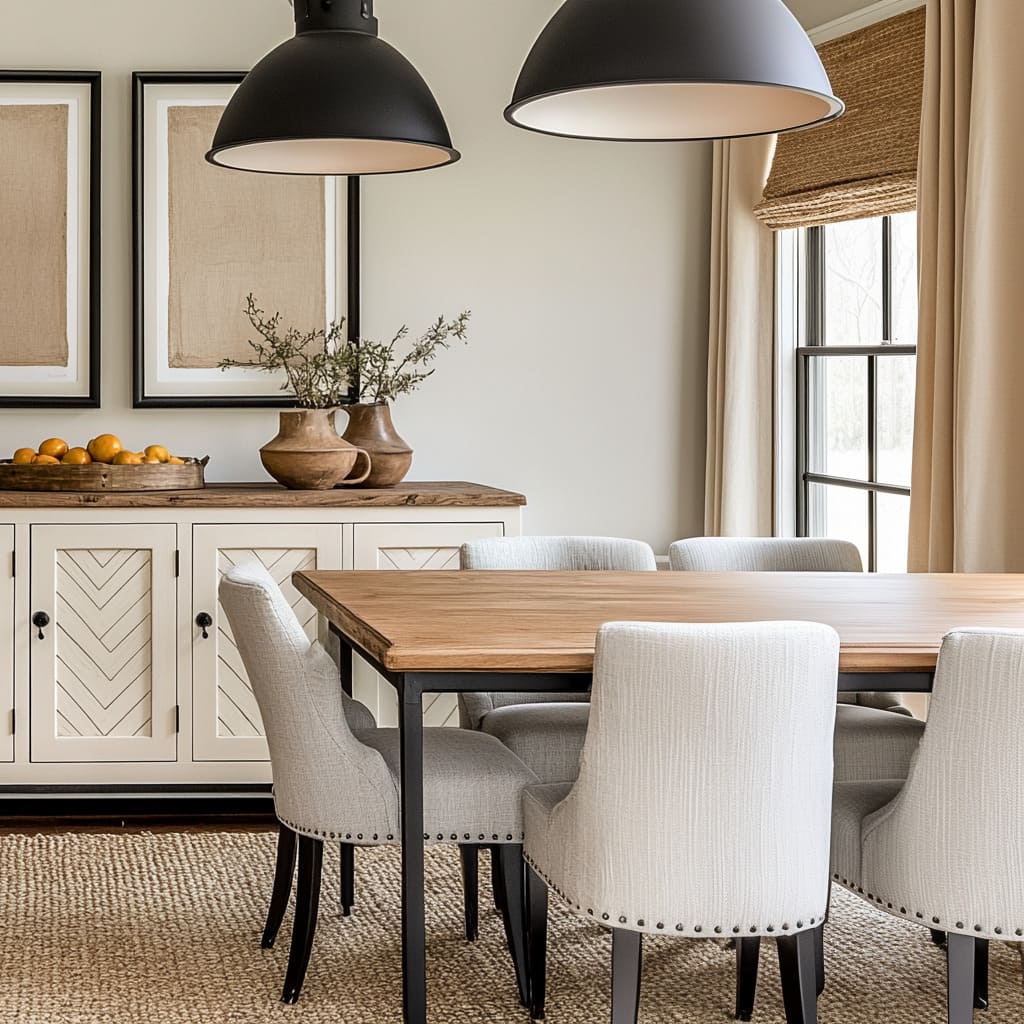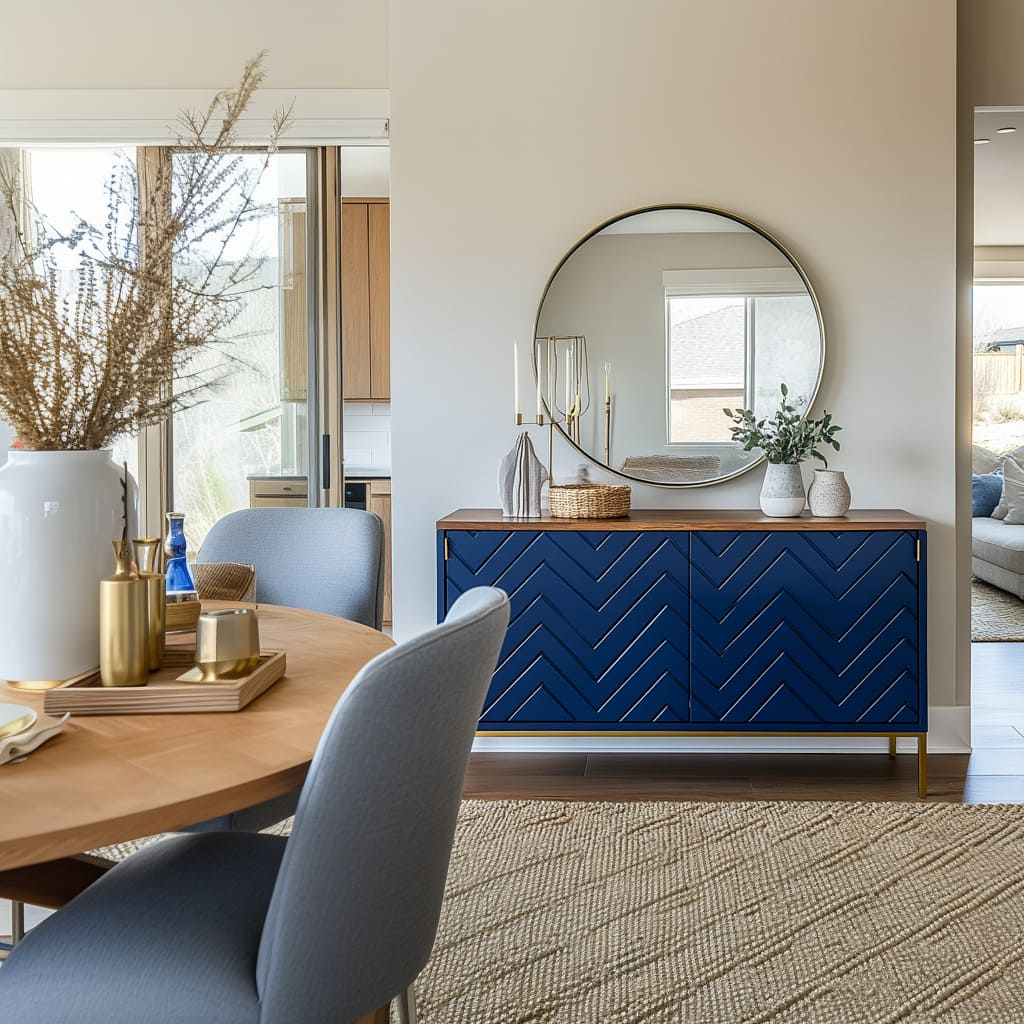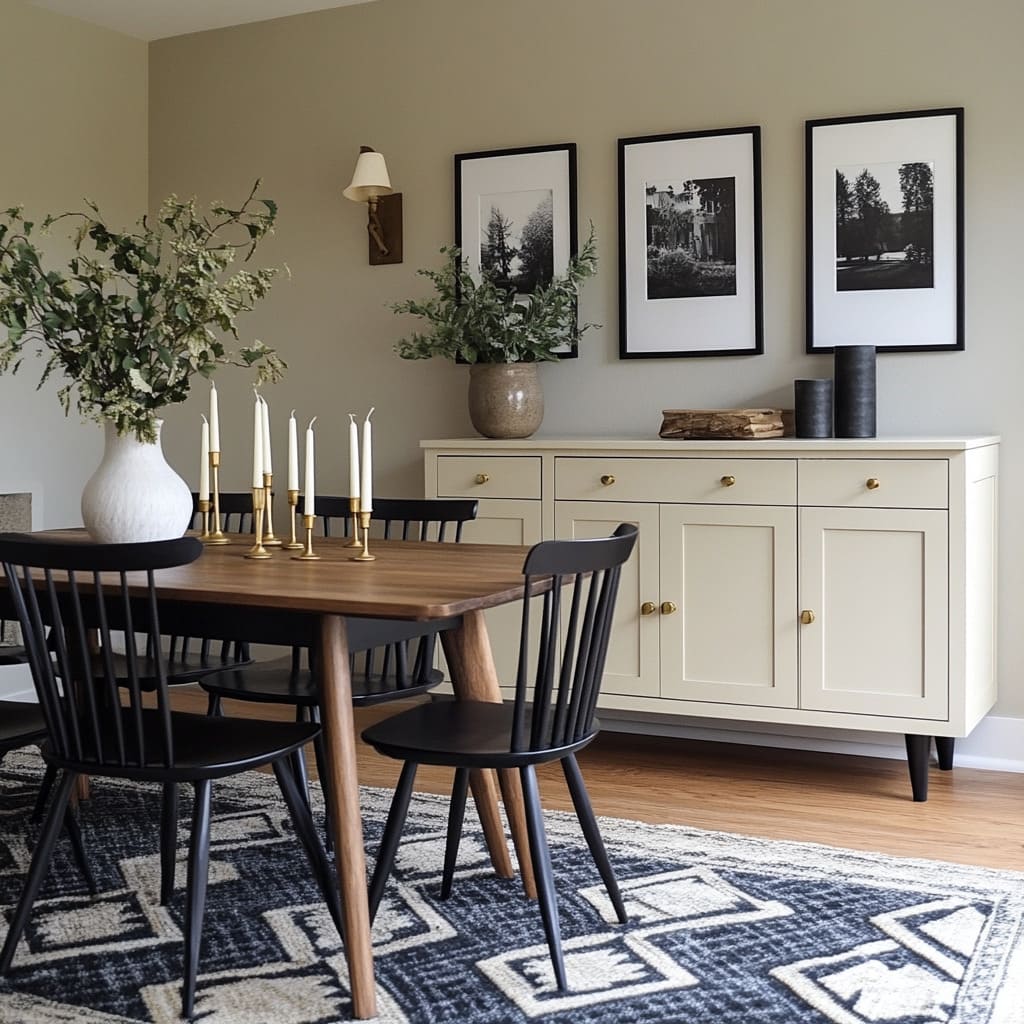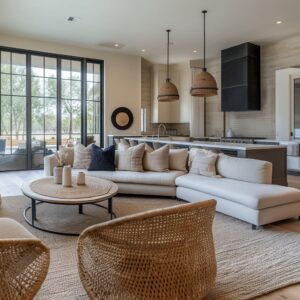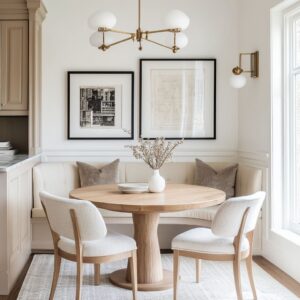The dining room isn’t just a place for meals—it’s where conversations unfold, where design meets practicality, and where small details make a big impact. Mid century modern dining room design ideas offer the perfect balance of clean lines, rich textures, and carefully curated accents, creating spaces that feel both stylish and inviting.
What makes this style so timeless? It’s the way bold sideboards become statement pieces, how warm wood tones and sleek metal finishes work together, and how lighting, furniture, and décor are layered to create depth.
Whether you’re drawn to deep greens and navy blues or prefer a more understated palette, mid-century dining spaces embrace contrast and simplicity in equal measure. This article breaks down the key design strategies behind these dining rooms, from color pairings and texture layering to furniture selection and lighting placement.
Instead of simply admiring a well-designed space, you’ll learn how to apply these expert techniques to your own home—ensuring that your dining area looks effortlessly put together while remaining functional for everyday use.
Subtle Cohesion via Repeating Motifs
One of the key techniques used by designers to create a visually connected and harmonious space is repeating certain patterns and shapes across different elements of a dining room. This approach ensures that even the boldest design choices feel intentional rather than overwhelming.
Chevron and Vertical Fluting
A recurring detail in mid century modern dining room ideas is the use of chevron or herringbone paneling on sideboards. This isn’t just an eye-catching decorative choice—it plays a structural role in how the room flows.
The diagonal lines naturally guide the eye, creating a sense of direction that subtly connects other elements in the space. You’ll often find that this pattern is echoed in artwork, throw pillows, or even chair upholstery, reinforcing a sense of rhythm without being overly repetitive.
Another technique designers use to bring subtle unity to a dining space is vertical grooving or fluting. Sideboards with vertically grooved doors create a structured, elongated effect that pairs well with taller design elements—whether it’s pendant lights with slim silhouettes, spindle-back chairs, or tall ceramic vases.
The vertical details make walls appear higher and introduce a refined, architectural texture without requiring additional décor.
Geometric Rhythm
Shapes play a huge role in balancing the overall look of a dining space, and contrast is often the secret ingredient in a well-designed room. While straight lines and sharp angles bring structure, they can sometimes feel too rigid on their own.
That’s where softer, curved elements come into play. A large round mirror placed above a linear sideboard is a perfect example of this balancing act.
Instead of the space feeling boxy, the circular shape interrupts the angular lines just enough to make the design more inviting. The same idea applies to dome pendant lights—their smooth, curved forms contrast beautifully with the crisp edges of furniture, preventing the room from feeling too structured.
Pairing sharp and soft geometry is another trick designers use to create a natural sense of movement. A sideboard with a chevron pattern might be positioned across from an oval dining table, or square-edged cabinetry could be softened by rounded-back dining chairs.
These subtle contrasts keep the space from looking monotonous, making the design feel layered and dynamic without overwhelming the senses. By thoughtfully repeating textures, patterns, and geometric contrasts, a dining space can feel both intentional and inviting—a hallmark of great mid-century modern design.
Textural Play and Layering
One of the easiest ways to make a dining space feel rich and visually engaging is through layering textures. This technique prevents a room from looking too flat, ensuring that even the most minimalist designs feel inviting.
In mid-century modern dining room design, texture plays a crucial role in balancing sleek furniture with natural elements.
Organic Textures in Rugs and Décor
A carefully chosen rug is more than just an accent—it grounds the dining area and enhances the contrast between smooth furniture and softer elements. Natural woven rugs, such as jute or sisal, are a common choice because their slightly rough texture breaks up the sleekness of wood or metal.
Underneath a dining table, they provide a tactile foundation that complements the clean lines of mid-century furniture. Beyond rugs, organic materials extend to cane, rattan, and ceramics, which introduce warmth without overpowering the clean aesthetic.
A sideboard with cane-paneled doors softens the look of solid wood cabinetry, bringing in a handcrafted touch that feels timeless. Similarly, rattan-backed dining chairs add a light, breathable element that pairs effortlessly with darker wood finishes or bold-painted furniture.
These details create a subtle play between structured and relaxed design elements, ensuring the space feels both curated and comfortable.
Mixed Materials on Sideboards
Sideboards in mid-century spaces rarely rely on a single finish. Instead, designers often mix painted surfaces with natural wood tops, creating contrast that keeps the furniture from feeling too heavy.
A deep emerald or navy sideboard with a warm oak or walnut top, for instance, balances color with organic texture, making the piece feel grounded yet refined. This mix also helps tie in other furniture finishes, ensuring that different wood tones across the space don’t clash but rather work in harmony.
Brass is another material that frequently appears in mid-century spaces, adding contrast to natural finishes. When incorporated into sideboard handles, lamp bases, or decorative accents, brass acts as a subtle highlight, catching the light and adding a sense of depth to the space.
To avoid an overly polished look, designers often balance brass with organic elements—dried florals, wooden trays, or hand-thrown ceramic vases. This interplay keeps the materials feeling layered and approachable, rather than overly styled.
By blending these textural elements, a dining room feels dynamic and thoughtfully arranged, rather than simply following a trend. Whether it’s through woven textiles, raw wood finishes, or metallic details, layering textures ensures that the space remains visually balanced and inviting.
Strategic Color Distributions
Color is one of the most effective tools in shaping the atmosphere of a dining space. In mid-century dining room ideas, bold hues aren’t just decorative—they define the overall composition of the room.
When used correctly, strong colors like deep green, navy blue, or terracotta bring depth and character without overwhelming the space. The key lies in knowing how to balance these shades and distribute them thoughtfully.
Deep Greens, Blues, and Terracotta
One of the most striking features of mid-century design is the use of strong, statement colors to anchor the room. These bold hues often appear in sideboards, acting as a visual anchor that draws the eye.
However, a well-designed space doesn’t stop at just one bold piece—designers extend the color throughout the room in smaller doses. For example, an emerald green sideboard might be complemented by ceramic vases in similar tones, subtle touches in patterned textiles, or even a framed print that includes hints of the same shade.
This method keeps the color woven naturally into the space, rather than making it feel like an isolated statement piece. To ensure these bold colors don’t overpower the room, they’re often paired with neutral backdrops.
Beige, warm white, and soft taupe walls allow deep blues or greens to stand out without making the room feel closed in. Even in spaces with dark furniture, designers maintain balance by keeping curtains, rugs, or larger upholstered pieces in lighter tones.
This contrast helps maintain an open and airy feel, even when deep hues dominate the furniture.
Two-Tone Techniques
Instead of using a single solid color, many sideboards in mid-century spaces feature dual-tone designs. This technique prevents large furniture pieces from feeling too heavy, allowing them to blend seamlessly with the rest of the décor.
A common approach is a light upper portion and a darker lower half, such as a cream-colored cabinet top paired with charcoal-hued doors. The result?
A sense of dimension that makes the piece more visually dynamic while highlighting architectural details like grooves or chevron paneling. Beyond the sideboard, chairs also play a role in creating color cohesion.
Designers often reference small details—like the black legs of a sideboard—in the dining chair frames. This doesn’t mean the entire set has to match, but subtle nods to the same finish ensure a consistent and thoughtful aesthetic.
A brass-accented sideboard, for instance, might be paired with dining chairs featuring brass-capped legs or gold-framed wall art, subtly tying the look together without making it feel forced. By distributing color strategically—whether through accent pieces, contrast techniques, or subtle connections between furniture elements—a dining space can feel cohesive, inviting, and effortlessly stylish.
Lighting Nuances
Lighting does more than illuminate a dining space—it shapes how the entire room feels. The right lighting can make a bold dining set stand out, enhance the warmth of wooden surfaces, or soften the edges of darker furniture.
In mid-century interiors, lighting isn’t just functional; it plays a key role in defining atmosphere and visual balance.
Layered Light Sources
The foundation of a well-lit dining room starts with a statement pendant light. Large pendant lamps hanging over the dining table do more than just provide illumination—they act as a focal point, naturally drawing attention to the table and reinforcing its presence in the space.
This is especially important when the furniture features deep wood tones or moody colors like navy, charcoal, or emerald green. Without a strong overhead light source, these colors can absorb too much light, making the space feel heavy.
A well-placed pendant keeps the dining zone bright and inviting. Beyond the main light fixture, secondary lighting is essential to create depth and highlight key features.
A floor lamp with a sculptural arched arm can gently illuminate a sideboard, enhancing the display of decorative objects without overpowering them. Wall sconces are another subtle way to bring warmth to shadowed areas, ensuring that the room doesn’t feel too stark once the main light is turned off.
By layering different light sources, a dining space avoids the common pitfall of feeling flat or one-dimensional. Instead, lighting becomes an active design element, emphasizing textures, accentuating furniture details, and helping the space feel well-balanced.
Reflective Amplification
Mirrors are often overlooked as part of a dining room’s lighting strategy, but they play a huge role in maximizing brightness. A well-placed mirror doesn’t just reflect the room—it amplifies the glow of nearby chandeliers or pendant lights, effectively doubling the impact of the light source.
This is particularly useful in spaces with smaller windows or darker accent colors, where natural light needs a little boost. Positioning a mirror directly across from a window can extend the feeling of openness, making a dining room appear more spacious.
Alternatively, placing a large mirror above a sideboard creates a dynamic effect—capturing and redistributing light while also adding a touch of refinement to the wall. The best dining rooms don’t rely on a single source of illumination.
Instead, they layer different lighting elements to enhance the furniture, create warmth, and make sure every detail is seen in the best possible light.
Unexpected Pairings that Designers Employ
One of the most interesting aspects of mcm dining room ideas is the way designers mix styles that, at first glance, might not seem like they belong together. By blending raw, rustic textures with sleek modern finishes, or pairing industrial details with soft upholstery, the space gains depth and contrast without feeling forced.
These unexpected combinations create a balanced look where every element plays off the other, resulting in a dining room that feels curated rather than overly coordinated.
Rustic + Refined
One of the most striking contrasts in mid-century dining spaces is the pairing of raw wood with polished brass accents. A live-edge dining table with its organic, uneven surface might seem like a better fit for a rustic farmhouse setting, but when placed next to a brass-handled sideboard with a high-gloss finish, it takes on a whole new character.
The contrast between the two materials keeps the room from leaning too far in one direction—the wood brings warmth and authenticity, while the brass details add a touch of refinement. Another approach to blending rustic and modern elements is the combination of classic Windsor chairs with contemporary cabinetry.
These chairs, originally designed for colonial-era homes, have made a huge comeback in modern interiors. When paired with a sleek, minimalist sideboard in deep navy or forest green, they add just the right amount of vintage charm without making the space feel outdated.
The key to making this pairing work is in the color choices—repeating finishes or tones across the furniture helps unify the look while keeping the contrast intentional.
Industrial Elements + Soft Upholstery
While mid-century dining spaces often feature wood as a dominant material, many designers introduce industrial-inspired metal details to add structure and contrast. A common example is a dining table with slim black metal legs, which can feel a bit stark on its own.
To balance this, designers often choose upholstered dining chairs in soft, neutral fabrics, making the space feel more inviting. This mix of materials ensures that the industrial touches don’t overpower the room, while the fabric seating adds comfort and warmth.
The trick to making industrial elements blend seamlessly into a mid-century setting is subtle repetition. If a dining table has black metal legs, that same black finish might reappear in a pendant light, picture frame, or even a sleek bar cart in the background.
These repeating details help tie the space together, ensuring that the industrial accents feel like part of the overall design rather than an afterthought. By carefully balancing opposites—polished with raw, metal with fabric, vintage with modern—a dining space gains personality and dimension.
These intentional contrasts make the design feel layered and inviting, proving that sometimes the most unexpected pairings create the most memorable interiors.
Nuanced Styling of Sideboard Surfaces
A beautifully styled sideboard can transform a dining room, acting as both a functional storage piece and a curated display that sets the mood for the entire space. In mid century dining room design, styling is never random—it’s an intentional mix of form, balance, and contrast that enhances the furniture’s character without overwhelming it.
Height Variations
One of the most effective techniques for making a sideboard arrangement feel visually engaging is playing with height differences. A well-styled surface isn’t about symmetry—it’s about creating movement through varying object heights.
Designers often place a tall vase or sculptural lamp at one end, followed by a mid-sized element like candlesticks, and finish with a lower item, such as a bowl or a stack of books. This layered approach keeps the eye moving naturally across the space, rather than landing on a flat, uniform lineup of objects.
Mixing reflective and matte finishes also adds depth. Pairing a sleek metallic candleholder with a rough-textured ceramic vase introduces contrast, preventing the display from looking too polished or too muted.
The interplay between light-catching surfaces and softer, organic materials ensures that even a minimal arrangement has plenty of visual interest.
Keeping Decor Minimal but Intentional
A less-is-more approach works best when styling a mid-century sideboard. The goal is to highlight the furniture itself rather than overshadow it with excessive decorations.
A common setup might include a single tray with fresh fruit, a sculptural vase, and a couple of carefully selected books. This restraint allows bold colors or intricate wood grain to remain the focus, rather than competing with clutter.
Organic elements, like dried florals or simple greenery, are another signature detail. A tall, sculptural branch in a ceramic vase introduces movement, while a smaller potted plant softens the edges of a brightly painted sideboard.
These touches subtly echo the natural materials commonly found in mid-century interiors, reinforcing a sense of warmth and balance. The secret to styling a sideboard effectively lies in curating instead of decorating—choosing meaningful, well-proportioned objects that complement the space rather than fill it.
With the right mix of height, texture, and negative space, a mid-century sideboard becomes more than just furniture—it becomes a design statement.
Chairs as Subtle Bridging Elements
In a well-designed dining space, chairs do more than provide seating—they serve as a visual connection between different design elements. Whether it’s through color, material, or form, the right dining chairs can tie the whole room together without feeling overly coordinated.
The trick lies in striking a balance between harmony and contrast, ensuring the chairs work with the space rather than blending in too much or standing out awkwardly.
Color Echo
One of the easiest ways to create a cohesive yet dynamic look is through subtle color repetition. For example, if the sideboard is painted in a rich cobalt blue, incorporating mid-century modern dining chairs with blue upholstery—or even just blue piping along the edges—can create a sense of connection without looking overly matched.
This approach ensures that the sideboard remains the statement piece, while the chairs quietly reinforce the palette. Beyond upholstery, wood finishes also play a key role.
A dining chair with a walnut or oak frame naturally complements a sideboard that features the same wood tone, even if the rest of the chair is upholstered in a contrasting fabric. When chairs echo the materials or colors of the larger furniture pieces, the result is a room that feels intentional and layered rather than disjointed.
Form Connections
It’s not just color that matters—the shape of the chairs can influence the balance of the entire dining space. If the sideboard has a bold, geometric pattern or structured paneling, softer curved chairs can help tone down the angular presence.
On the other hand, if the sideboard features rounded corners or smooth, organic shapes, choosing chairs with sharper lines or a more structured silhouette adds contrast, preventing the room from feeling too uniform. This push-and-pull between soft and sharp forms is one of the most effective ways to create a well-balanced mid-century dining space.
It ensures that every piece, while unique, contributes to the larger composition, resulting in a dining area that feels both visually engaging and comfortable.
Integrating Functional Elements into Aesthetic Choices
A well-designed dining space isn’t just about appearance—it needs to function effortlessly for everyday life. Whether integrating technology or ensuring a smooth layout, designers find ways to merge practicality with style so that a room remains both visually appealing and highly usable.
TV Above Sideboard
Placing a TV above a sideboard is a practical solution that works especially well in open-concept spaces where the dining and living areas blend together. Instead of letting the screen dominate the room, designers use clever tricks to make it feel like part of the décor.
One approach is to match the sideboard’s finish to the surrounding wall or furniture, making the television appear less like an add-on and more like a natural extension of the design. To keep the space feeling intentional, symmetrical elements like sconces, framed artwork, or a pair of decorative vases are often placed on either side of the sideboard.
This helps distribute focus so that the eye isn’t drawn only to the screen. Another key consideration is cable management.
Exposed wires can instantly make a stylish space look cluttered. Many designers solve this by using sideboards with built-in openings for cables, keeping electronics neatly tucked away.
If a sideboard lacks designated storage for devices, small decorative items—like books or trays—can be strategically placed to help conceal any remaining cords.
Openness and Flow
For those working with an open-plan layout, creating a natural flow between the dining area and adjoining spaces is essential. One way to achieve this is by repeating finishes or accent colors across different zones.
For example, a wooden sideboard in the dining area might share the same tone as the kitchen cabinetry, or a navy blue buffet could tie into deep-colored seating in the living space. These small connections ensure that the dining area doesn’t feel separate but rather part of a larger, well-thought-out composition.
Furniture placement also plays a crucial role in maintaining a sense of openness. Designers often position dining tables so that there is consistent walking space around them, allowing sideboards to be approached from different angles.
This ensures they remain functional—not just for storage but also as a serving station during meals or gatherings. By blending practical elements with smart design choices, a dining room can feel just as functional as it is stylish, making the space work effortlessly for both everyday use and special occasions.
Thoughtful Use of Walls and Accessories
The way walls are styled in a dining space can make or break the overall design. A well-chosen piece of art, the right mirror placement, or strategically positioned lighting can completely transform the look of a dining area, making it feel more refined and intentional.
Instead of treating walls as an afterthought, designers use them to extend the visual impact of the furniture, ensuring that the space feels layered and complete.
Art and Mirrors
A large-scale artwork above a sideboard isn’t just a decorative touch—it helps balance the proportions of the room. If the artwork is too small, the furniture beneath it can feel oversized, making the wall look disconnected from the rest of the space.
Choosing a canvas or framed piece that closely matches the width of the sideboard creates a sense of alignment, making the display feel well-proportioned and visually anchored. Color also plays a major role.
Artwork with hints of brass, deep wood tones, or black can subtly echo the finishes in the furniture, reinforcing a cohesive palette across the space. This small detail ensures that the wall doesn’t feel like a separate design element but instead works as an extension of the dining area’s color scheme.
Mirrors serve a dual purpose—they enhance light and expand the room’s visual depth. A well-placed mirror can reflect natural or artificial light, making the space feel brighter and more open.
When positioned above a sideboard, a mirror creates a subtle layering effect, adding dimension without overpowering the furniture below.
Sconces and Small Shelves
Lighting isn’t limited to overhead fixtures. Wall sconces flanking a sideboard provide both function and style, casting a soft glow that highlights the texture of cabinet doors or the artwork above.
This technique adds warmth to the space, ensuring that the dining area doesn’t rely solely on overhead lighting. For those looking to add subtle storage or display space, floating shelves can be a great solution.
Short, well-placed shelves above or beside a sideboard can hold small decorative objects, glassware, or framed prints, continuing the visual lines of the furniture onto the wall. This keeps the space feeling curated while providing a practical way to display meaningful pieces.
By integrating wall décor thoughtfully—whether through art, mirrors, lighting, or shelving—a dining space gains depth, balance, and a sense of completeness. These details may seem small, but they play a significant role in elevating the overall look and feel of the room.
Applying These Insights to Your Own Dining Room
Bringing a well-designed dining space to life isn’t about following rigid rules—it’s about balancing color, shape, and function in a way that feels natural. Whether working with an existing setup or starting fresh, a few key strategies can help create a dining room that feels cohesive, stylish, and practical.
Identify a Focal Finish
The sideboard is often the anchor of the dining space, so choosing a standout finish—whether a deep navy, soft sage, or natural wood tone—sets the stage for the rest of the design. Once you have this main piece, echo its color subtly in other areas, like chair upholstery, decorative vases, or artwork.
This keeps the space feeling intentional rather than disconnected.
Balance Shape and Texture
A dining space feels much more dynamic when contrasting textures and shapes are used thoughtfully. If your sideboard has bold geometric lines or strong panel details, consider softer dining chairs with curved backs to create contrast.
The same principle applies to materials—pair natural elements like rattan, cane, or jute with smooth lacquered finishes or polished brass. This mix prevents any one element from feeling too dominant, giving the room a sense of balance.
Mind Your Lighting Layer
Lighting does more than illuminate—it sets the entire mood of the dining area. A single, dramatic pendant light above the table creates a strong focal point, but the space needs more than just overhead lighting.
A table lamp or floor lamp near the sideboard helps soften the ambiance, especially in the evenings. This layered approach prevents the room from feeling too stark or one-dimensional.
Curate Décor Thoughtfully
It’s easy to overload a sideboard with decorative objects, but less is often more. Start with a couple of statement pieces—perhaps a tall sculptural vase and a stack of books—then adjust as needed.
Leaving intentional empty space ensures that the furniture itself remains the star, rather than being lost in clutter.
Reflect and Enlarge
If your dining room feels compact, a strategically placed mirror can work wonders. A mirror above the sideboard not only reflects light, making the space feel more open, but also enhances design details by creating visual depth.
This trick works especially well in dining areas with darker furniture or moody wall colors, where a mirror can prevent the space from feeling too enclosed.
Connect Elements Across Zones
For open-concept layouts, repeating small design details in adjoining spaces ensures a smooth visual transition. A dining room with black metal chair legs might reference the same finish in a nearby coffee table, or a brass-accented sideboard might subtly tie into kitchen hardware.
These repeated touches help unify separate areas, making the space feel well-planned without looking overly matched. By thoughtfully layering colors, materials, and décor, a dining space can feel both functional and effortlessly stylish—a place that looks curated but remains inviting for everyday use.
Final Thoughts
Each of these dining spaces highlights the versatility of mid-century style, showing how color, material choices, lighting, and accessories work together to create a well-balanced look. While the design details vary, certain key principles remain consistent—bold sideboard colors paired with neutral walls, a careful mix of geometric and organic shapes, and layers of texture that add depth without overwhelming the space.
The beauty of these design approaches is that they don’t rely on strict formulas. Instead of trying to recreate an exact setup, the best results come from adapting these techniques to fit your own space.
Whether it’s incorporating a statement sideboard, experimenting with contrasting materials, or refining the way light interacts with your furniture, the goal is to build a dining room that feels cohesive yet uniquely personal. By thoughtfully blending these elements, you can achieve a space that’s as inviting as it is stylish—one that works effortlessly for both everyday meals and special gatherings.
